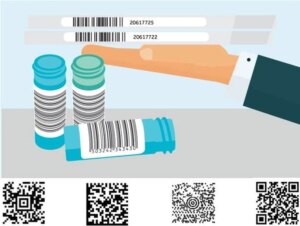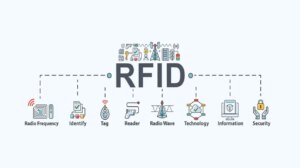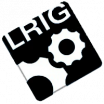Barcodes are the most popular tool in Automatic Identification and Data Collection (AIDC) when it comes to sample identification and tracking. These universally recognized codes play an important role in ensuring the precise identification and management of your most valuable assets, including your samples.
Barcoding is already used in many modern laboratories, helping to streamline processes, enhancing efficiency, and aiding with accurate specimen tracking. However, if you’re just getting started, we’re here to help you explore the world of laboratory barcoding and Radio Frequency Identification (RFID) technology. In our guide, we’ll explain its benefits, ways that it can be implemented, and the methodology to follow for precise specimen labeling.
The Origin of Barcodes
The barcode originated in 1952 and was inspired by Morse code, but instead of dots and dashes, thin and thick bars and spaces were used to create unique patterns that a machine could read. Fast forward two decades and barcodes had become a commercial sensation.
Railcars were the first to embrace the barcode in the 1960s. Large linear barcodes were fixed to the sides of railcars, which could then be monitored by devices each time they entered and exited the yard. In 1974, the first consumer product with a barcode – a 10-pack of Wrigley’s gum – was scanned at a checkout in an Ohio grocery store. That moment changed the retail landscape for good.
Differences Between Linear and 2D Barcodes
In the lab environment, barcodes have numerous benefits. First, they eliminate the need to decipher a badly handwritten label. They also offer a seamless solution for data entry, so you can say goodbye to mistyped numbers and characters. A simple scan and all the data you need is captured almost instantly with no human input errors.
Barcodes come in several different shapes and sizes, each tailored to specific applications and requirements, but there are two primary code structure types: linear barcodes and two-dimensional (2D) barcodes.
What are Linear Barcodes?
Linear barcodes are known for their simplicity, featuring bars and spaces arranged horizontally to allow for easy scanning. In the lab, they’re often used for tubes, vials, and microwell plate labels as they’re well-suited to quick and efficient identification tasks.
This type of barcode can also have redundancy in their design, with bars and spaces duplicated vertically. If a portion of the barcode is obscured or damaged, this redundancy ensures the data can still be accurately interpreted. Whether you scan the top, middle, or bottom of the code, you’ll retrieve the same information.
What are Two-Dimensional (2D) Barcodes?
2D barcodes are more advanced and are designed to store a wealth of information within a smaller space. They cannot only store numbers, but also more complex information that includes characters and symbols with prefixes or suffixes. Instead of bars and spaces, 2D barcodes use a pixel grid arrangement of dark and light elements. This compact and data-rich format makes them perfectly suited to applications where space is limited, and information tracking is crucial.
While linear and 2D barcodes have differences, they both share a common purpose: accurate data identification. The best choice for your lab will depend on your intended use and the scanning equipment available.
Barcode Symbologies and Density
To understand barcode symbologies, it’s best to think of them like languages. No matter whether you say a word in Spanish or English, you’re trying to communicate the same thing, just in different ways. When it comes to barcodes, instead of words, it’s all about different patterns of white spaces, black spaces, and varied bar lengths. The density of the code is another way to describe how closely packed the bars and spaces are. You can download the Barcode Design Compass to dive deeper into barcode density and symbology.
Barcode Printing Techniques and Best Practices
To ensure the quality and readability of your barcodes, it’s important to understand the different printing techniques available and the significance of proper orientation. There are two primary orientations to consider: ladder configuration and picket fence orientation. These terms refer to the arrangement of the bars and spaces within the barcode.
Ladder Configuration
In this orientation, the barcode printer activates its printhead frequently, turning it on and off as it prints the bars and spaces. While it gets the job done, this method can result in slightly blurrier barcodes.
Picket Fence Orientation
With this approach, the barcode printer keeps the printhead on for an extended period while printing the bars and spaces. This continuous flow of heat creates cleaner, more defined barcode images.
Environmental Considerations
In the lab, barcodes must be able to withstand different environment conditions. This could range from exposure to chemicals and extreme temperatures to abrasion. To counteract damage, the material of your labels should be tailored to the container, whether it’s a polypropylene tube or a glass vial.
It’s also worth considering how the container will be stored and handled. If tight racks are involved, for example, the tolerance between the tube’s circumference and the rack must be factored in to determining the thickness of the label and its adhesive properties. Otherwise, your label could peel off or interfere with your machinery.
RFID: The Latest Technology in Automatic Identification and Data Collection
RFID can be considered the barcode’s high-tech cousin. It leverages radio waves for data transmission and doesn’t require any visual contact with the tag to be scanned. Even so, it’s important to recognize that it’s not a simple swap; RFID requires its own distinct infrastructure, and making the move over from barcodes can be a substantial technological undertaking.
Diving Deeper into RFID
RFID tags have an exceptional storage capacity, holding information that extends far beyond simple identification. Dynamic data pertaining to the item’s state or activities can all be accommodated. RFID technology also offers data encryption. As a result, RFID deployment is more expensive than using traditional barcodes, but it really shines when it comes to inventory management. Its proximity scanning capabilities and ability to read and write data means that, even if items are concealed behind other objects, RFID scanners can still work.
Choosing Between Barcodes and RFID
When comparing barcodes vs RFID, there are several things to consider. Your laboratory’s economic considerations, operational environment, and existing infrastructure will all help determine the right option for you. While RFID can offer proximity scanning and data writing, these advantages must be balanced against its higher implementation costs.
Both barcodes and RFID technology are tools designed to enhance efficiency, accuracy, and data tracking. No matter which option you choose, both will continue to play a vital role in the tracking and identification of the things that matter most. Check out our Laboratory Labeling Products Guide or get in touch with one of our experts to find out more.
Connect with our labelling experts today
Blog article form
"*" indicates required fields



















